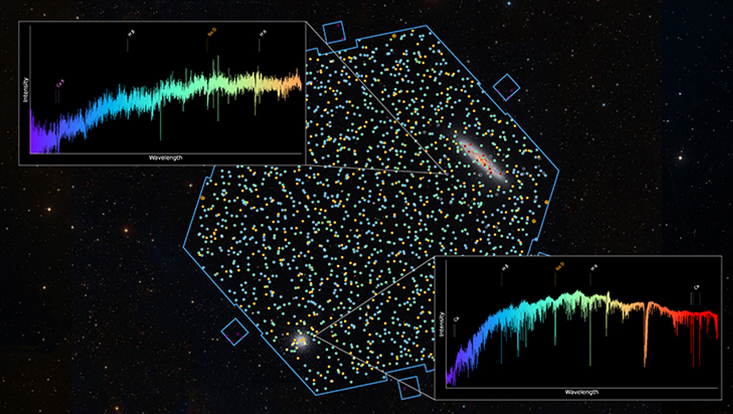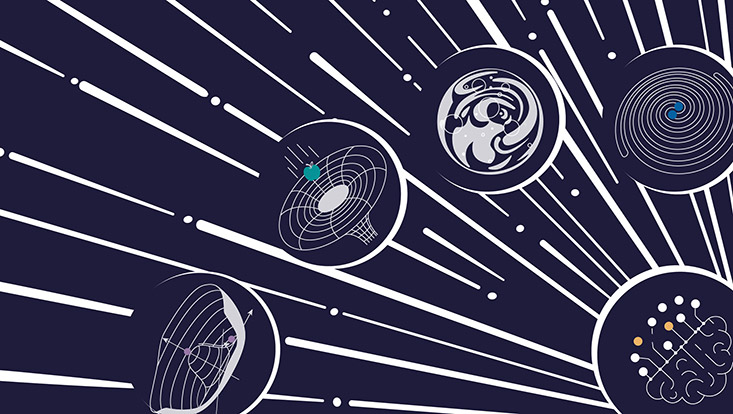Axion searchCrucial progress in the MADMAX experiment
24 July 2025

Photo: MPP
In the Shielded Experimental Hall (SHELL) at the University of Hamburg, an international research collaboration involving the Cluster of Excellence Quantum Universe is developing the MADMAX experiment to detect axions. The particles are considered promising candidates for dark matter and could solve a mystery surrounding the strong nuclear force. In the current project phase, the research team tested and evaluated various approaches for detecting the axion. The new findings have now been published in two articles in Physical Review Letters.
So far, the axion has only existed in theoretical models. What makes the extremely light particle so interesting is that it could significantly advance two research topics in particle physics. One of these is the composition of dark matter. The second is a specific, but not yet understood, feature of the strong interaction which makes quarks stick together in protons and neutrons, thus ensuring stable atomic nuclei.
Theoretical particle physics unambiguously predicts that inside a magnetic field cosmic axions trigger an oscillation of the electric field. This prediction is the basis for the MADMAX experiment: Using a very strong magnet, scientists try to make the oscillation detectable as microwave radiation. However, the theory does not make precise predictions about the frequency of the expected extremely faint microwave signal. “You can think of axion experiments like a radio receiver,” says Béla Majorovits, scientist at the Max Planck Institute for Physics and spokesperson for the MADMAX Collaboration. “The axion transmits its signal at an unknown frequency and we have to tune our radio precisely to this frequency to detect it.”
Focus on a previously unmeasured frequency range
Current experiments are looking for axions in the range of several hundred megahertz, i.e. in the radio wave spectrum. However, plausible theoretical models predict that the oscillation caused by axions is at a significantly higher frequency. The MADMAX experiment will search the bandwidth from 10 to 100 gigahertz. To do this, a so-called booster that amplifies the conversion of vacuum oscillations into microwaves is used, thus increasing the signal strength by many orders of magnitude.
This innovative booster consists of several disks that are positioned in front of a mirror and are permeable to microwaves. The vacuum vibrations are converted into microwaves at the surfaces of the mirror and the disks. The multiple reflections of the waves between the mirror and the disks generate resonances and thus amplify the signal. In order to obtain reliable and reproducible results with MADMAX, it is important to determine the exact ‘boost factor’.
First measurements with a booster prototype
The research team has now succeeded in determining the amplification effect of the booster for the first time. To do this, the scientists used two complementary methods: In the first approach, the booster is irradiated with microwaves and similar resonances arise as if they were excited by axions. By measuring the strength of these resonances, the amplification factor can be directly determined. The second method is based on the reflection behavior of the booster. This can be used to determine the key parameters required to calculate the amplification effect.
Thanks to this preliminary work, it has now been possible to search for dark matter axions with a prototype booster. For this purpose, the booster was brought to CERN and the measurements were carried out in the 1.6 Tesla magnetic field of the MORPURGO magnet. Although the research team did not find the axion they were able to top the most sensitive measurements to date in two frequency bands.
Having reached this important milestone, the international research group is confident that it will be able to further optimize the booster and the detection methods in the coming years. As a next step, further measurements are planned for 2027 to 2029 in the MORPURGO magnet at CERN, which will use a further developed prototype booster. The final experiment will then be set up at the DESY laboratory in Hamburg.
The weakness of the strong force
The axion could not only explain dark matter, but also solve a central problem in particle physics: the so-called strong CP problem. This concerns the question of why the strong force that holds the quarks and gluons together in the atomic nucleus is symmetrical when the direction of time is reversed. The Standard Model of Particle Physics actually predicts the opposite.
The problem can be illustrated using the example of a glass of water. A glass of water remains a glass of water, regardless of when you look at it. Even if you rewind time a few minutes like in a video, it remains a glass of water. It is different with a glass containing an ice cube: at room temperature, it would melt over time. If you now reverse the direction of time, the melted ice cube will freeze again – at room temperature that does not actually allow this. In this case, we would speak of an asymmetry with reversed time direction.
According to the Standard Model, the strong force is not symmetrical when the direction of time is reversed. However, there is no evidence for this. The axion could resolve this contradiction between theory and practice: The particle could combine with the quarks and gluons and thus prevent asymmetry from appearing.


